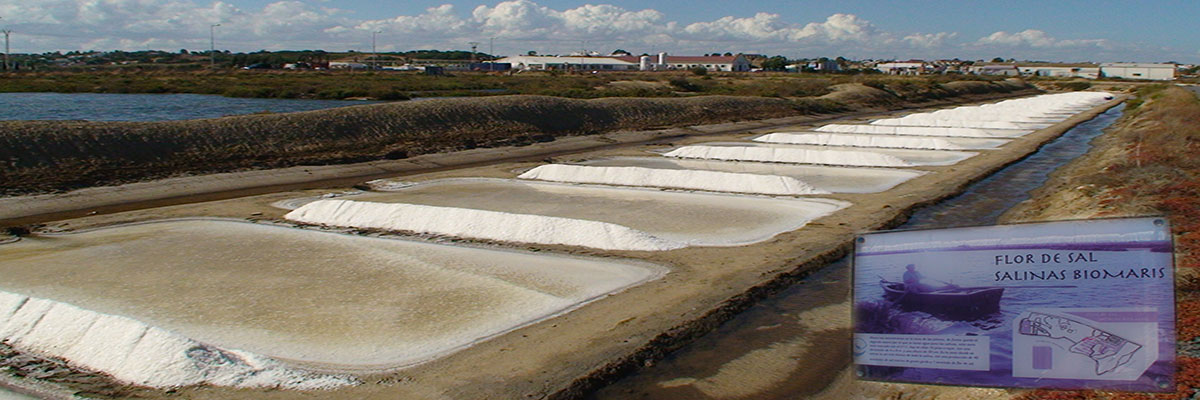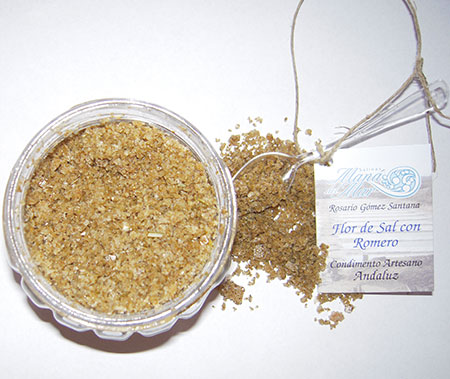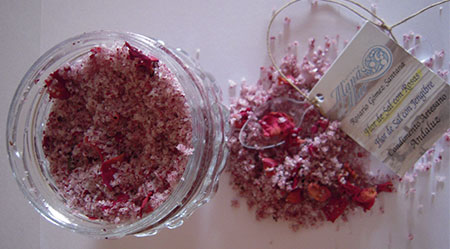"All the good with a pinch of spice"

In Huelva and Cadiz we are surrounded by national parks. These parks which are not only set in the mountains and woodlands also take up vast tracts of land along the coastline. It is in these parks that many of the traditional salt flats are located. By using the word traditional here I am excluding all the salt flats where salt is harvested using machinery. It is great to see the centuries old methods of harvesting salt still surviving today and they will survive for years to come simply down to the superior quality their products have to offer.
Of course I am no expert in this matter but I have Rosario Gómez Santana and Francisco Castillo Rodriguez owner of “Flor de Sal” traditional salt flats in Isla Cristina to steer me in the right direction and bring you all into this world of salt. The whole system of the salt flats has it own language and methods and Francisco who has spent nearly all his life harvesting salt from the salt flats is going to explain how it all works.
All of you have taken a dip in the Atlantic Ocean know that it is a good bit colder than the adjoining Mediterranean but at the same time it is a lot cleaner.
Francisco explains that the water that flows in from the sea is normally four or five degrees Celsius, this water flows into a pool called “Estero”, marsh. Here the water warms up to approximately seven degrees and then is let flow into areas called “sifones” , funnels. The water warms up to about 10 degrees Celsius and from here is passed on to the “calentadores” heating pools where the sun takes the water up to 15-16 degrees Celsius. The water then passes into the “corridor or tajo” corridor or stream around the evaporation pools where it reaches the ideal temperature of 25 degrees Celsius before the “Ojal” (a hole in the evaporation pool wall) is opened with a stick to fill the evaporation pool. When the water reaches 27 degrees Celsius in the evaporation pools salt crystal form and the harvest of salt can truly begin.
There are five different types of salt that can be harvested and although it is Francisco and his hardy workers that harvest the salt, it is Rosario who explained the how they harvest each type and the different qualities each of these different salts offer:
Flor de Sal
 The salt crystals which form on the surface of the water in the evaporation ponds are called Flor de Sal, Flower of salt. It is harvested off the top of the water when the salt crystals form, usually in the hot summer afternoons. “This salt is the highest quality salt we have and it is used to give that final taste to your dishes and also in cold sauces. It is pure white with a smooth texture but a crunchy taste and only the traditional salt flats offer this type of salt. It has less sodium and is rich in magnesium, calcium, fluorine and iodine. All this minerals are what your body needs to keep a good balance. Of course taken in correct amounts like everything else” said Rosario.
The salt crystals which form on the surface of the water in the evaporation ponds are called Flor de Sal, Flower of salt. It is harvested off the top of the water when the salt crystals form, usually in the hot summer afternoons. “This salt is the highest quality salt we have and it is used to give that final taste to your dishes and also in cold sauces. It is pure white with a smooth texture but a crunchy taste and only the traditional salt flats offer this type of salt. It has less sodium and is rich in magnesium, calcium, fluorine and iodine. All this minerals are what your body needs to keep a good balance. Of course taken in correct amounts like everything else” said Rosario.
Salt Pyramids
The flor de sal which is not skimmed off the surface before nightfall is left for the next morning and harvested in the form of crystals in the shape of pyramids. The salt has nearly all the same qualities as the flor de sal only that it doesn’t dissolve as quickly.
Hojas de sal/ Salt flakes
Hojas de sal or salt flakes are suspended in the water and are harvested using a fine net attached to a poll similar to those used when cleaning a pool. “ This salt is used for cooking fish, meat and many other food and has a stronger taste than the previous two salts, it absorbs some of the juices from the food being cooked” said Rosario
Espuma de sal/ salt foam
 This salt is a mixture between salt flakes and flor de sal and it builds up in the corners of the evaporation ponds on windy days. “We don’t harvest a lot of this salt but it is great for cooking” said Rosario
This salt is a mixture between salt flakes and flor de sal and it builds up in the corners of the evaporation ponds on windy days. “We don’t harvest a lot of this salt but it is great for cooking” said Rosario
Sal gordo / cooking salt
This salt is raked from the base of the evaporation ponds using a “roll” a long poll with a flat plank attached vertically to one end. “This salt is humid and has magnesium which is important for the central nervous system and it has numerous uses. For swimming pools, relaxing baths, curing ham, all types of salting” said Rosario.
Seeing the salt been harvested is a sight unto itself but the crunching sound as the salt is harvested is like nothing I have ever heard before. The next time you are near a salt flat in the summer I strongly recommend you take time to visit. Rosario also prepares flor de sal with special herbs and spices and there is even one with rose petals. She also gave me a great tip for keeping the colour in your coloured clothes: a handful of cooking sal in the drum before the wash.
On a final note for all of you out there who like salt but the doctor has told you to cut back, get some Flor de sal. If you are going to keep using salt this is by far the healthiest option. My Spanish mother in law highly recommends it and of course she also recommends Lyons Irish green tea.